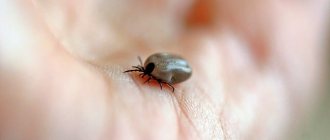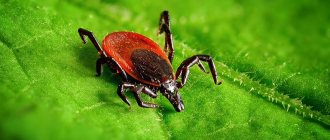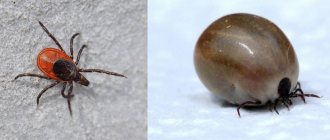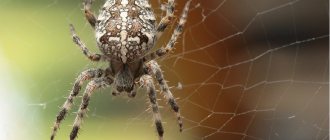Check yourself, loved ones and your pets for ticks whenever you are outdoors—especially from April to late July and early fall. Many people mistakenly think that they can feel when a tick bites them, the same way they feel a mosquito bite. But ticks are very dangerous and cunning bloodsuckers, and they have evolved through some complex, almost science-fiction-like mechanisms. Let's take it in order..
- Why are ticks dangerous for humans and pets?
- Where are ticks most common?
- Where can you catch a tick?
- How and when can you treat an area against ticks?
- Bitten by a tick: what to do
- How do you still remove the tick?
- What to do with a removed tick
- What to do if it is not possible to get tested for tick-borne infections
- How to protect yourself from a tick bite
- Ticks and pets
Why are ticks dangerous for humans and pets?
Everyone knows that ixodid ticks carry encephalitis. But alas, everything is not limited to encephalitis: these arthropods can also transmit to their victims borreliosis (Lyme disease), anaplasmosis, ehrlichiosis, tularemia, hemorrhagic fever and several other diseases with equally frightening names and no less frightening consequences. In addition, pathogenic bacteria can live in the tick's mouthparts, causing severe skin damage.
For pets, piroplasmosis is a great danger - a tick-borne infection that can kill an animal in just a few days.
Consequences of crushing a tick
After extraction, the tick will naturally go in search of food to find a new victim. You can destroy it by crushing the tick with your fingers (nail), but you should take into account the danger of splashing the contents of the gastrointestinal tract. If it gets on unhealed wounds, scratches or microcracks, there is a risk of infection.
The insect's chitinous cover is highly durable, comparable in density to human nails, so crushing a tick can be quite difficult. To do this, use solid objects.
Where are ticks most common?
The Moscow region as a whole is not considered an endemic region for encephalitis (except for the Dmitrovsky and Taldomsky districts), and supervisory authorities state that registered cases of the disease are isolated, and their source is imported, that is, the tick bite was received in other regions. However, this is not a reason to relax: firstly, ecologists fear that an increase in average annual temperatures may lead to an expansion of the habitat of encephalitis ticks; secondly, there is always a risk of getting an infection from the list above from an infected tick. For example, every year in Russia 7-9 thousand people fall ill with tick-borne borreliosis.
The period of greatest danger for tick-borne encephalitis is April-July.
Closeup of a tick
Body structure of a water mite
Hydracarines, like all arachnids, have four pairs of legs. At the end of each leg there are two claws, which allow the individual to crawl and capture prey, as well as swimming hairs, used for movement in the water.
The body is often round and consists of a cephalothorax and abdomen, which are visually almost fused together. Depending on the species, the water mite has either two or four eyes. Biological scientists believe that the eyes of hydrocarines, protected by durable chitinous capsules, see perfectly even in muddy water, which gives predators an advantage.
Chelicerae and pedipalps help mites absorb and retain food. The palps hold the prey near the mouth, and the claws of the chelicerae pierce the skin or chitinous shell, after which the water mite sucks out the prey.
They breathe using the entire surface of the body. The tick absorbs oxygen dissolved in water and survives even at extremely low concentrations (1 part per million).
In addition, Hydracarinae are characterized by sexual dimorphism, that is, the female and male of the same species can differ significantly in size.
It is noteworthy that water mites completely lack a circulatory system. Also, their body does not have a hindgut and anus. These organs are replaced by an excretory opening located immediately above the intestines.
How and when can you treat an area against ticks?
In large cities, according to reports from local authorities, work to combat ticks is carried out at the level of treating the territories of children's institutions and places of public recreation. In Soviet times, green areas were treated by spraying DDT from the air, but in the 1980s this practice had to be abandoned for safety reasons: the drug is toxic, does not decompose in the external environment, and can accumulate in the soil and penetrate into water sources.
Experts advise treating the area and border area when snow thaws appear: during this period, ticks emerge from suspended animation. Kleschevit Super will help protect your homestead territory from ixodid ticks . It is advisable to carry out the treatment 3 days before the arrival of people and animals at the dacha. The product begins to act within 30 minutes after treatment and protects against ticks for about a month
Ixodid tick
Types of ticks in the house
Several species of these dangerous arachnids can exist in the vicinity of humans. Moreover, some of them not only live nearby, but also prefer to feed on the blood of people and pets. And the waste products of others cause the development of allergies.
Dusty
This mite is most often found in apartments. The insect is small in size from 0.1 to 0.5 mm, so it is impossible to see it with the naked eye. The mite feeds on dust, which is why it got its name. The insect is widespread on all continents. 1 g of dust can contain up to 150 species of dust mites.
Dusty
The life cycle of the insect is 65-80 days. Dust mites can live and reproduce in an apartment all year round. Optimal conditions: temperature within +18…+250С and high humidity.
A female dust mite makes hundreds of clutches throughout her life, each containing 60 eggs. The waste products of this species are one of the causes of the development of bronchial asthma.
Ixodes
This type of tick is considered one of the largest, its body size reaches 2.5-4.5 mm. The color of the insect is brownish-brown. Ixodid ticks are found on all continents except Antarctica and are able to live in any climate zone. This species belongs to the blood-sucking category. Insects live on the street, in parks, gardens, forests, hiding in thickets of grass and bushes, waiting for their prey. They prefer warm, humid places.
Ixodid ticks are especially active in spring and late summer. But some individuals cannot sleep even in winter. Forest ticks enter apartments on the fur of pets, people’s clothing, in baskets with mushrooms, and also with bouquets of wild flowers.
How long a forest tick lives in an apartment depends on the availability of favorable conditions. For full life, it needs soil and moisture. Therefore, it cannot exist in a human home for a long time, but even its short-term stay in the house threatens residents with serious health consequences.
Ixodes
Bed
This type of arachnid insect belongs to the category of synanthropes. The bed mite has a microscopic size, its body length reaches no more than 0.5 mm, so it is impossible to detect it without a special device. It feeds on dead skin particles and dandruff. It is impossible to suffer from the bites of these parasites, since they do not feed on human blood. But this does not make them any less dangerous than their counterparts.
The lifespan of such insects is 65-80 days, but without food in the apartment, the tick is capable of falling into suspended animation and remaining there for four years until favorable conditions appear. The female lays from 3 to 8 thousand eggs throughout her life.
Bed
Bitten by a tick: what to do
First of all, don't panic. It is clear that the first desire is to immediately get rid of “this disgusting thing,” especially since many experience an unaccountable fear of insects and creatures similar to them.
It is strictly forbidden to pull out a tick : part of it will remain under the skin. The oral apparatus of ticks is designed in such a way that it is literally screwed into the skin, like a screw, so pulling it out can only worsen the situation.
You should also not pick a tick out of your skin using sharp objects at hand: this will only spread everything contained in its saliva throughout your body.
And never listen to advisers who suggest dousing a tick with oil , Vaseline, alcohol, urine or some other folk remedies: this will not produce any quick effect, the tick will not begin to choke and will not leave its place, but it can reflexively release an additional amount of infected material into the wound saliva. In addition, it will be much more difficult for you to remove an “oiled” tick from the skin. It is better not to touch the tick again, not to press on its abdomen and to do everything as carefully as possible.
Attached tick
Reasons for appearance
Even in a completely new and clean apartment, ticks can appear. Let's consider the main reasons for this phenomenon. Neighbours. Ticks, unlike other insects, such as bedbugs, do not migrate from apartment to apartment. However, neighbors can also bring it on their clothes or with some things. New things, technology. Furniture and equipment, before appearing in your apartment, were in stores or warehouses, where in any case there is dust, and this means there may well be mites. Pets. As a rule, dogs walk outside and can bring mites along with dust on their fur.
How do you still remove the tick?
In popular sources you can see a recommendation to go to the nearest trauma center. This is correct, but not always feasible: in practice, it may take several hours to drive to a medical facility, and you will spend another couple of hours there in line - a tick bite is not considered an emergency, so you will not be seen right away. Meanwhile, the tick should be removed as soon as possible after detection - this reduces the likelihood of getting an infection. Therefore, after weighing all the pros and cons, it most often makes sense to remove the tick on the spot. Anyone can do this, as long as their hands don't shake.
The most convenient way to remove a tick is with a special extractor , similar to a small nail puller. Such devices are sold mainly in pet stores. The tick is carefully picked up by the slot of the tool “by the neck” (between the abdomen and the human skin) and twisted. You can find a video of this operation on the Internet - it is very simple. Contrary to popular belief, the direction of rotation is not important: you will see for yourself in which direction a particular plier turns easier.
Tick removed by extractor
Of course, you may not have an extractor at hand - in real life, this is most often the case. In this case, you can use regular thread . In the middle, a loop is tied with a tightening knot, this “noose” is thrown over the tick - again “under the abdomen”, the knot is carefully tightened - without unnecessary effort, but so that the tick is hooked securely. Then the ends of the thread are folded together and all that remains is to twist them with two fingers: in this way the tick is unscrewed in just a couple of seconds. The advantage of this method is that the thread is easy to find even far from civilization - for example, to pull it out of clothing. Problems can arise if the tick has burrowed into the scalp: it can be difficult to catch a tick in the hair with a thread. It is not easy to remove a tick this way even in men with abundant body hair.
Extracting a tick with a thread
Removing ticks with tweezers is also practiced, but few people carry tweezers with them all the time. In addition, when removing a tick with a metal tool, an awkward movement can tear off the head of the tick or crush the abdomen.
After the tick is removed, the wound should be treated with any available antiseptic (in extreme cases, strong alcohol will do). Hands should also be disinfected or washed well with soap after contact with a tick. It is, of course, advisable to carry out all manipulations in medical gloves, but they are carried even less often than tweezers or an extractor.
If you still tear off the tick and the head remains in the wound, it will be clearly visible in the form of a black dot. It is not recommended to get it out on your own - you will still have to go to the doctor. In the most extreme case, if there is no way to get medical help, the remains of the tick are very carefully removed with a needle sterilized over a fire, and the wound is washed with a disinfectant.
Ixodid tick: natural size
Life cycle of hydrocarine
The average lifespan of a water mite is just over a year. Copulation (reproduction) begins in the spring, since hydrocarines are not very active in winter. In winter, most hydrocarines are in the nymphal (larval) stage of development.
The reproductive strategy of different types of ticks can differ significantly. For example, males of the species Piona nodata can swim for a long time, looking for a female and lowering the claws of the third pair of legs into a special pocket on the abdomen where seminal fluid accumulates. Having noticed a female of its species, the tick quickly swims up to her and transfers the seed into her genital opening.
But males of the Arrhenurus species behave differently. Arrenurus females have significantly larger body sizes, so the males have to use a trick: they attach to the lower part of the abdomen using a sticky secretion, after which mating occurs and the seminal fluid is introduced into the genital opening.
After fertilization, females of some species (Limnochares aquatica, Eylais), mainly living in stagnant water of swamps and small ponds, lay a clutch of eggs on underwater snags, stones or plant roots. The same mites that live in flowing water firmly attach a clutch of eggs to plant stems. Those hydrocarines who live in sea water find coastal stones immersed in water and parts of underwater structures (piles, bridges, etc.) for these purposes.
The further course of development of the water mite is quite complex and requires the sequential passage of the following stages:
- The eggs hatch into larvae. They have three pairs of legs and an elongated body. In small bodies of water with an abundance of zooplankton, hydrocarine larvae can cover the entire surface of the water,
- after finding a host, the larvae attach to its body and successfully parasitize it,
- then the pupation process begins, which occurs on the same host,
- After pupation, the larva turns into a nymph, the size of an adult. This metamorphosis allows you to hunt small aquatic organisms and maintain life activity,
- secondary pupation. Surprisingly, metamorphosis alone is not enough to form an adult and viable water mite. Repeated pupation, again occurring through parasitism on the body of another organism, completes the development cycle.
During the entire cycle, the water mite forms and sheds two molt skins, and also passes through three nymphal (larval) stages.
What to do with a removed tick
The most common and reasonable recommendation is to take the tick to a laboratory where it can be examined for infections. Unfortunately, this is not easy to do in practice. First of all, the tick must be examined alive, so it must be placed in a tightly closed jar with damp cotton wool or a cloth at the bottom. Even with all the precautions, it will not live there for long - you may simply not have time to deliver it to the right place, and the accuracy of examining a dead tick is reduced. If you manage to quickly take a tick to the city, you will most likely find that there are very few government laboratories that accept ticks for analysis, you are not particularly welcome there, and the analysis itself is paid. It probably makes sense to immediately contact commercial diagnostic laboratories - in the list of tests they most often offer this one, as of March 2020 its cost is about 2 thousand rubles, and they examine the tick for several of the most common pathogens at once (encephalitis, borreliosis , ehrlichiosis and anaplasmosis), results are provided in 1-4 days.
If you killed the tick during extraction or realize that there is no way to deliver it to the laboratory, this is not particularly scary. It is possible to detect tick-borne infections before symptoms appear; to do this, after 10-14 days you need to go to the laboratory and donate blood from a vein. Such an analysis in some private diagnostic centers can cost even less than a tick examination.
What to do to secure your home?
Firstly , as a preventive measure, always inspect the clothes and all items that you bring into the apartment. Especially after trips “out into nature”. The same applies to pets; check their fur, ears, and paws before you enter your home.
Secondly , if you already know that an uninvited guest has settled in your house, you will need to take a number of measures to detect and destroy the parasite.
Where does it hide and how to find a tick in an apartment? It is clear that these are secluded places where it is warm and has enough moisture. If a bug “successfully entered” your apartment and hid securely, it is not a fact that you will be able to quickly find and neutralize it. It can hide for up to ten years, thanks to its physiological characteristics.
Be sure to read it ! What to do if you are still bitten by a tick?
But it is unlikely that this is your case. Most likely, in a few days the bug will die, but all this time you will experience an unpleasant feeling of disgust and fear of being attacked by a tick, which is certainly infected with all infections at once.
How to get rid of ticks in an apartment and what can be done at the initial stage:
- review your clothes, especially dark ones;
- Place blankets and carpets in the sun;
- vacuum upholstered furniture, cracks in the floor, baseboards;
- Inspect the pet's bedding and fur.
Now comes the most important stage - to use special means to poison ticks in the house and certainly get rid of the parasites. For these purposes, preparations designed specifically for killing insects are suitable.
Neostomozan
Neostomozan is an insectoacaricidal liquid for dilution with water. To treat the animal, dilute 1 ml of Neostomosan with 200 ml of water, moisten the dog or cat's fur or spray it with a spray bottle. When working with the drug, you must be careful and carefully read the instructions.
Neostomozan is an effective remedy for treating apartments against ticks. Using the prepared solution, treat the room. The product is used against ticks, fleas, flies and other parasites. You can buy Neostomozan at any pet store.
Breeze-Anticlesh
We’ve figured out how to treat an apartment against ticks, now let’s determine a product for treating clothes and textiles. An acaricidal acaricidal agent, Breeze-Anticlesch, is suitable for these purposes. The price of a 140 ml bottle is 330 rubles.
What to do if it is not possible to get tested for tick-borne infections
All that remains is to observe your condition (or the condition of the bitten family member). Any unusual symptoms, fever, flu-like condition, rashes or other skin changes in the bite area are a reason to immediately consult a doctor. When infected with borreliosis, a characteristic sign is a rash around the bite or redness in the form of a ring - the so-called annular erythema, but its absence does not mean that there is no infection: in 20-30% of cases, erythema does not occur. When contacting a doctor, be sure to tell them that there was a tick bite - cases of misdiagnosis, unfortunately, are not uncommon.
Ring-shaped erythema
Characteristic signs of the presence of bed mites
In the vast majority of cases, ticks live in the sofa, bed and linen without showing their presence. Without examining the tissues under a magnifying glass, it is impossible to determine their presence. At the same time, it should be taken into account that an increase in the number of these parasites has a negative impact on human health.
Adult linen mites defecate at least 20 times a day. Feces that come into contact with human skin can cause severe allergic reactions. Some people experience not only a severe skin rash, but also a feeling of general malaise, nervousness, sleep disturbance and fatigue. Among other things, often in the first days of an allergic reaction, an increase in body temperature is observed.
An increase in the number of bed mites can provoke inflammatory damage to the mucous membrane of the eyes, accompanied by lacrimation and severe redness. In addition, allergic rhinitis and sneezing may develop without obvious signs of a cold. There are cases where ticks have caused bronchial asthma. When bed mite numbers increase, symptoms may worsen. If people living in an apartment with a large number of linen mites are not prone to allergic reactions, they may not even be aware of such a neighborhood
How to protect yourself from a tick bite: 4 secrets
1. Dress appropriately. It is a myth that ticks can jump. Most often, the tick sits on the tip of a blade of grass, approximately at the level of your ankle or shin. The danger is especially great where warm-blooded animals regularly pass - for example, near livestock grazing or roads along which livestock are driven. When a person passes by, the tick attaches itself to clothing - most often to the bottom of trousers, crawls under them and begins to move from bottom to top in search of an area with thin and delicate skin. Less often, a tick can be “caught” with a sleeve - for example, when picking plants, berries or mushrooms, or when moving through tall grass or bushes. Therefore, when visiting the forest, wear long sleeves with cuffs that fit tightly to the skin; It is advisable to tuck trousers into high socks, top clothing into trousers, and tie a scarf or bandana on your head. Ticks do not fall from above, but over some time they can crawl from the legs to the head and end up in the hair, where they are not immediately detected. It is advisable that the clothes be light-colored - this makes it easier to notice a tick crawling on it. Do not walk through the forest in shorts, a T-shirt and open shoes. If possible, stay away from areas where livestock or other animals regularly pass.
2. Use special tools. The use of special tick repellents is also effective. These products are not particularly cheap, but they perform well. Be sure to read the instructions before use! Most tick repellents are intended for use only on clothing and equipment and should not be applied directly to the skin. In addition, the expiration date indicated large on the packaging (in hours or even days) corresponds to reality only if the instructions for processing and storing clothing are followed.
3. Examine yourself and your loved ones. When in the forest, if possible, inspect yourself and those around you for ticks. At home, after returning from the forest, this must be done; the inspection must be thorough and in bright light. Particular attention should be paid to parts of the body where the skin is thin and delicate: these are the areas under the knees, hips, groin, abdomen, buttocks, armpits, inner arms, neck, and in women - the area under the breasts. If there is a lot of hair growing on the body, the inspection should be very careful: there are quite small mites, and this may not be noticed in the hair. After this, wash yourself well, things should be washed, if possible, in hot water, and/or ironed well with a hot iron, especially the seams. Do not store the clothes you wear when working in the country, going to the forest or hiking, together with other things: at least wrap them tightly in a bag.
4. Get vaccinated. Vaccination is considered the best way to prevent tick-borne encephalitis, but it is not included in the mandatory vaccination schedule and is given free of charge mainly to people who intend to travel to or live in an encephalitis-endemic region. You can voluntarily get vaccinated against encephalitis if you are willing to pay for it. But you should know that vaccination is carried out according to a special scheme; in order to form stable immunity, the vaccine is administered several times throughout the year, starting in the fall, revaccination is required every 3-5 years. There is also a simplified, so-called emergency regimen, which includes two injections of the vaccine with an interval of 14 days. In this case, immunity is formed after 2-3 weeks and persists throughout the season; after 9-12 months another injection is given.
There are no vaccinations against borreliosis and other tick-borne infections, except for encephalitis, so even vaccinated people must take all precautions.
Methods of control and prevention
Low temperature and humidity.
Ticks die at temperatures below 10 degrees. In addition, they require high humidity to survive, and they cannot survive in a dry environment.
Wet cleaning of the apartment.
Mandatory cleaning removes dust and along with it mites. If you add floor cleaning products to the water, the effect will be significant.
Washing bed linen and upholstered furniture at high temperatures.
Ticks die at a temperature of 60 degrees.
Freezing.
When frost is below 10 degrees, insects die.
Special bedding.
You should use special dust-proof mattress covers and change them once a week.
Ciliate soil.
The use of an insecticide developed on the basis of infusor soil makes it possible to combat both house and garden mites.
Minimum indoor plants.
This is recommended to avoid spider mites. In addition, the presence of indoor plants increases the humidity in the room.
Essential oils.
Used to repel insects.
Vacuum cleaner.
Using such a device, you can perform deeper dust cleaning.
Ventilation.
Creates an unfavorable atmosphere for the reproduction and development of ticks.
Rugs and slippers.
The greatest likelihood of bringing ticks from the street and from the entrance. Therefore, the rug near the door and slippers should be cleaned and washed regularly.
Air filter and cleaner.
Effectively cleans the room of dust and mites in it.
Minimalism.
By getting rid of unnecessary things, we deprive ticks of their habitats.
Steam generator.
Treatment of mattresses, upholstered furniture, carpets with hot steam.
Ozone generator.
Used for disinfection of premises.
Ticks and pets
As already mentioned, ticks can cause many diseases, including piroplasmosis. This disease most often affects dogs and is insidious in that in the first stages it can manifest itself with weak and unnoticeable symptoms - the animal becomes less mobile, eats poorly, and sleeps a lot. Often the owner of the animal is not alarmed by this, especially since it is not always possible to track a previous tick bite: if the animal has long hair, the tick can only be detected by accident, and even if the owner regularly examines the dog, the tick may simply not be noticed. As a result, the disease progresses and manages to enter the acute phase, at which treatment is already quite difficult and does not guarantee the pet’s survival. Characteristic signs of piroplasmosis in animals are high temperature, rapid weakening of the hind limbs (the animal walks poorly, cannot rise from a lying position), and a reddish tint to the urine. The disease progresses quickly: if treatment is untimely or absent, most animals die 4-6 days after the onset of the acute stage.
Tick in animal fur
To protect pets from ticks, veterinary drugs are used in the form of drops, tablets, sprays, etc. Even anti-tick overalls for dogs are offered, but their effectiveness is questioned. Special shampoos are also considered unreliable because they do not have a prolonged action. Experts advise using products (drops on the withers or special collars) that create a protective effect for 1-3 months.
In nature, carriers of piroplasmosis can be wild animals, primarily canines - foxes, wolves, raccoon dogs, so owners of domestic dogs are advised to avoid contact with them at all costs.
A vaccine against piroplasmosis exists and is used, but its effect is rather weak: it does not protect against infection in all cases and can only provide a milder course of the disease and a higher survival rate of vaccinated animals.
Is it possible to touch a tick with your hands?
If a pest is detected on the skin, it is recommended to immediately visit the hospital to receive first aid. After extraction, the insect is sent for examination, which should confirm or deny the presence of dangerous viruses. You should resort to removing the tick yourself in the absence of qualified assistance.
An insect getting on the skin and moving through the body without a bite does not pose a threat, since it is impossible to become infected with dangerous diseases in such a situation . When containing the parasite, you need to follow basic safety rules. A small risk arises when, when crushed, the contents come into contact with the skin with signs of damage (an open wound, a cut).
Once on the body, the parasite begins to choose the best place to penetrate. The insect can bite, but suction does not occur. It is at such a moment that an infection can be introduced into the victim’s body.
Interesting! The insect's proboscis resembles a bolt that is screwed in due to a fine thread.
Tick habitat.
Mites' favorite places to live are the dustiest corners of your home, where it is difficult or even impossible to reach for cleaning. Such places are:
- Natural feather pillows.
- Mattresses, especially old ones that have not been cleaned for many years. There is an opinion that in such a mattress mites occupy 10% of the total composition.
- Quilts.
- Bed sheets.
- Upholstery of furniture - armchairs, sofas.
- Curtains and drapes.
- Bookshelves that are very rarely dusted.
- A bag for collecting garbage in a vacuum cleaner.
- Soft toys, mainly made of natural fabric.
- Old clothes that have been lying untouched for a very long time.
- Wool blankets.
Statistics say that the bed is the most common habitat of these insects; sometimes there are up to 2 million parasites in it.
As you know, due to bed mites, a person can develop an allergy; this is due to particles of parasite waste products that settle on various surfaces in the house and enter the human body through the respiratory tract.
Does the vaccine save?
The tick-borne encephalitis vaccine is usually given to those who are at risk of infection. For example, people whose work involves being in the forest. Absolutely all people do not need it. It will also not be possible to get vaccinated the day before a trip to the forest, since it is necessary to complete the entire vaccination course against tick-borne encephalitis two weeks before leaving for an unfavorable territory. The vaccine is free and is included in the list of services under the compulsory medical insurance policy.
When is the best time to get vaccinated against encephalitis? More details
Read more about mite allergies.
As you already understand, dust mites are the cause of severe allergies. Here are the diseases that can start because of this:
- Conjunctivitis, rhinitis
- Dermatitis
- Rhinoconjunctivitis
- Dangerous angioedema
- Bronchial asthma
In medicine, there is a term that unites all diseases that began as a result of contact with dust mites - mite sensitization.
You should be wary if you suddenly start sneezing frequently, wheezing in your lungs, a suffocating cough, and your eyes turn red and start to water. Contact your doctor and get the necessary tests to determine your allergy and begin treatment. Therapy consists of eliminating factors that provoke allergies, prescribing antihistamines and desensitization. These measures are aimed at reducing the body's reaction to allergens. It is worth noting that not all people necessarily develop allergies from contact with mites; it all depends on the person’s immunity. Therefore, if you do not show any symptoms, you cannot be sure that ticks are not attacking you.
Are all ticks encephalitic?
In Russia, the main carriers of tick-borne encephalitis are two types of ticks: taiga and dog ticks. The taiga tick is most often found in the forests of Siberia and the Far East, while the dog tick is found in the European part of Russia. An area where 1% of ticks are infected with the encephalitis virus is considered dangerous or endemic. As a rule, local authorities of Rosportebnadzor inform the population about which areas are dangerous at certain times, usually in early spring and early summer. Tick activity begins when the soil warms up to 5-7 degrees, that is, somewhere in April, and the largest number of bites occurs on the warm days of May and June.











